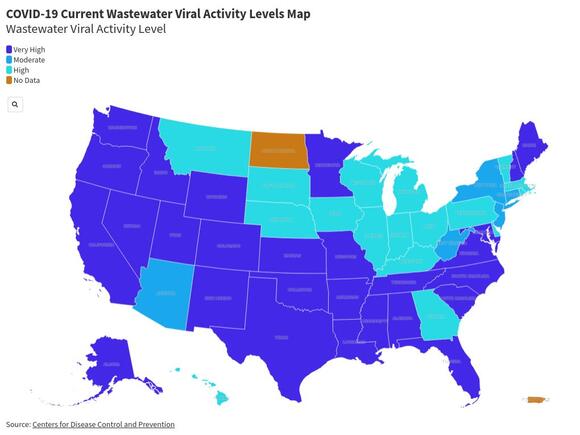
INDIANA—The Centers for Disease Control and Prevention (CDC) reports that over half of the United States has reported “very high” levels of COVID-19 activity.
The government agency says that using wastewater or sewage, the CDC tests the water to see if there are any traces of an infectious disease within a community.
Data collected on August 9 by the CDC showed that 27 states, including Indiana, reported “very high” levels of wastewater viral activity nationwide.
Here are the overall numbers of the states and territories that have reported wastewater viral activity levels as of Aug. 9.
COVID-19 Current Wastewater Viral Activity Levels Map

Click here to view the map.
District 8, which includes Lawrence, Monroe, Brown, Bartholomew, Jackson, Orange, and Washington Counties, has reported that the current seven-day average of those seeking emergency treatment with COVID-19 symptoms is 14. The number of emergency room visits since January is 302. Twenty people have been admitted to the hospital since January. One person has died since January.
The leading variant is KP.3. According to the CDC, symptoms of COVID-19 may appear 2-14 days after exposure to the virus. Possible symptoms of COVID-19 range from mild to severe.
How to prevent COVID-19
You can spread COVID-19 before you show symptoms. Some people with the illness never have symptoms but can still spread the disease. However, there are ways to protect yourself and others from getting COVID-19. These tips can help you and others stay safe:
- Get an updated COVID-19 vaccine. Vaccination helps prevent the spread of COVID-19 and can also prevent serious illness if you do contract it.
- Make sure children ages six months and older get the COVID-19 vaccine. Vaccinating children and teens helps prevent them from spreading COVID-19 to older relatives, young siblings, and friends who can’t or don’t get the vaccine. It also helps protect children and teens from serious illness.
- If you are vaccinated and live in an area with high COVID-19 hospital admission rates, you can wear a face mask or respirator that fits well without gaps when you are indoors or in public.
- If you have a weakened immune system, you may want to wear a face mask indoors in public regardless of how active COVID-19 is in your community.
- Avoid poorly ventilated indoor spaces and crowded areas, even if you are vaccinated. If you are indoors, open windows and doors and use fans to help bring in outdoor air when possible. Use a portable high-efficiency particulate air (HEPA) cleaner. Spending time outdoors or in well-ventilated spaces can help reduce your exposure to respiratory droplets.
- COVID-19 tests can help prevent the spread to others. You can use COVID-19 self-tests at home and get quick results whether or not you have symptoms.
- Wash your hands many times a day with soap and running water for at least 20 seconds. This is a good practice to help prevent the spread of germs. Do this before eating or preparing food, after using the toilet, and after coughing, sneezing, or blowing your nose. If soap and water are not available, use an alcohol-based hand sanitizer (at least 60% alcohol).
- Cover your mouth and nose with a tissue or sleeve (not your hands) when coughing or sneezing. Droplets released when a person sneezes or coughs are infectious. Throw away the tissue after use.
- Avoid touching your face, eyes, nose, and mouth with unwashed hands.
- Do not share personal items such as cups, eating utensils, towels, or bedding. Wash anything you have used in soap and water.
- Know the symptoms of COVID-19. If you develop any symptoms, contact your healthcare provider.
- Stay home if you think you have COVID-19 or test positive for the virus. Follow the guidance below for how long to stay away from others and when you can safely resume normal activities.
What to do if you get COVID-19
If you have COVID-19 or are experiencing symptoms of it, you must stay at home and avoid contact with other people, both inside and outside your home, to prevent the illness from spreading.
Once you start to feel better, you can go back to your normal activities if BOTH of the following things are true:
- For at least 24 hours, your symptoms have improved AND
- You have not had a fever for at least 24 hours, and you are not using fever-reducing medicine
Even though you feel better, you may still be able to spread the virus to others for several days. For this reason, once you go back to your normal activities, continue to protect others from illness by taking these steps for 5 days:
- Practice good hygiene by washing your hands and cleaning “high touch” areas around your home.
- Take steps to bring cleaner air inside your home by opening windows and using exhaust fans.
- Wear a mask around others.
- Practice physical distancing by avoiding close contact and avoiding crowds.
- Self-test for COVID-19 before being indoors with others.
You should also practice these steps for 5 days if you tested positive for COVID-19 but did not have any symptoms. Even though you have no symptoms, you can still spread the virus to others. Doing so will protect people at risk for serious illness, such as the immunocompromised.
If your fever returns after you resume normal activities, you should return to staying home and away from others. Once your fever and symptoms improve for more than 24 hours, you can resume activities while taking steps to protect others for 5 more days.



